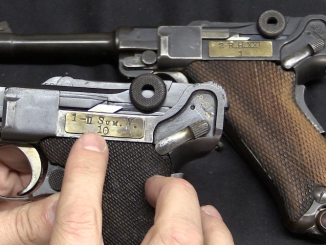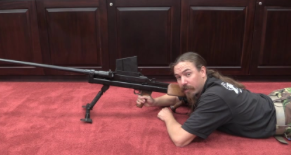The British went into the 1880s with plans to adopt the Enfield-Martini as its new rifle, a single shot Martini-action rifle with essentially a sidesaddle of ready-access cartridges on the side of the receiver. It would be chambered for a new .402 caliber black powder cartridge. However, the Small Arms Committee begin looking into the possibility of a magazine rifle instead, and trials of 40+ different systems found three worth considering: a Lee rifle with a box magazine, a Lee rifle with a Bethel Burton magazine, and the Owen Jones rifle. As these trials were concluding, the discovery of smokeless powder threw a wrench in the plans.
After study of the Swiss 7.5×53.5mm cartridge, the British opted to develop a small bore .30 caliber round themselves, which would be the .303 British. This round, originally loaded with compressed black powder before the use of cordite, rendered the plans for the .402 caliber Enfield Martini obsolete. What would have been a justifiable territorial and reserve rifle alongside a .402 magazine rifle was now an orphan. With the new rifle in .303 caliber, a .402 single shot Martini was just an added logistical overhead. Instead, existing Martini rifles would eventually be converted to .303 British.
At any rate, the Lee rifle and magazine were chosen as ideal, and in 1888 a batch was made for field trials across the British Empire. Widely positive reports led to its formal adoption and the beginning of production in 1889 as the Magazine Rifle MkI – later retroactively renamed the Lee Metford MkI and colloquially known as the Long Lee. The example we have today has two very rare original features; an intact manual safety and Lewes pattern sights. Both of these would be quickly removed or replaced in service, and a Mk I* and MkII pattern followed shortly after the adoption of the MkI.




“Oh no, I just shot someone in the knee!” I suspect that’s what happened when the manual safety was removed on later marks, but this assumption could be wrong.
Rob from Britishmuzzleloaders has a great video of bayonet drill practice for the Lee Medford rifle. https://www.youtube.com/watch?v=UR5KRqbPAVM
“With the new rifle in .303 caliber, a .402 single shot Martini was just an added logistical overhead. Instead, existing Martini rifles would eventually be converted to .303 British.”
Municion has article about this cartridge as .402 Enfield-Maritini
http://old.municion.org/Enfield/402EnfieldMartini.htm
If I understand Muchos de los rifles .402 Enfield-Martini no fueron terminados de fabricar completamente y se acabaron reconviertiendo a .45 Martini-Henry MK IV. correctly enough a lot of Enfield-Martini rifle in .402 were being made, but then converted to fire (old) .45 cartridge, before finished.
It also mention some relation to GARDNER crank gun, though I am unable to determine details. I hope someone better understanding español will help.
Here’s Google Translate’s version;
By “1886-1887 machine gun” I assume they mean the Maxim Mk I originally chambered for the .577/450 Martini-Henry black-powder round with the post-1883 drawn-brass cartridge case.
The long lever was of course introduced on the Martini-Henry to aid primary extraction in tropical conditions. With the original coiled brass foil/iron battery cup case, it equally of course mainly succeeded in tearing case heads off.
Results in a machine gun, mechanical or otherwise, would no doubt have been similar, especially after a few bursts had heated up the barrel(s).
cheers
eon
I don’t know the exact difference, but at Omdurman the British actually used volley sights and opened up on the Mahdist forces at some ridiculous distance. With real effect.
Sorry, that should be ‘exact distance.’
Volley sights and massed volley fire are good when you have a bunch of riflemen working away at some distant enemy who can’t take cover. Today’s equivalent would be a machine gun saturation attack (as opposed to suppressive fire). I could be wrong.
The reason the stock was designed in two pieces was that Enfield had on hand vast numbers of Martini stocks blanks
It is also relevant that the Remington-Lee Stock proved very prone to splitting just to the rear/left-side area of the action.
This is very evident in surviving (model 1899) ‘Lee Small-Bore Magazine Rifles’, in .30-40 caliber, such as the one adopted by the State of Michigan.
Possibly, the British personnel, involved in perfecting a Magazine Rifle, saw this potential ‘Achilles Heel’ in the Lee Stock design and adapted the Lee to a robust separate Butt & Socket design.
why is the stock so dark? is it painted or is it the wood?